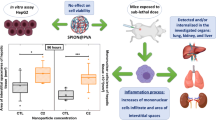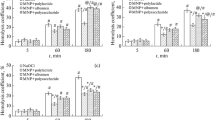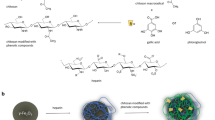Abstract
Superparamagnetic iron oxide nanoparticles (SPIOn) are widely used as a contrast agent for cell labeling. Macrophages are the first line of defense of organisms in contact with nanoparticles after their administration. In this study we investigated the effect of silica-coated nanoparticles (γ-Fe2O3–SiO2) with or without modification by an ascorbic acid (γ-Fe2O3–SiO2-ASA), which is meant to act as an antioxidative agent on rat peritoneal macrophages. Both types of nanoparticles were phagocytosed by macrophages in large amounts as confirmed by transmission electron microscopy and Prusian blue staining, however they did not substantially affect the viability of exposed cells in monitored intervals. We further explored cytotoxic effects related to oxidative stress, which is frequently documented in cells exposed to nanoparticles. Our analysis of double strand breaks (DSBs) marker γH2AX showed an increased number of DSBs in cells treated with nanoparticles. Nanoparticle exposure further revealed only slight changes in the expression of genes involved in oxidative stress response. Lipid peroxidation, another marker of oxidative stress, was not significantly affirmed after nanoparticle exposure. Our data indicate that the effect of both types of nanoparticles on cell viability, or biomolecules such as DNA or lipids, was similar; however the presence of ascorbic acid, either bound to the nanoparticles or added to the cultivation medium, worsened the negative effect of nanoparticles in various tests performed. The attachment of ascorbic acid on the surface of nanoparticles did not have a protective effect against induced cytotoxicity, as expected.








Similar content being viewed by others
References
Singh N, Jenkins GJ, Asadi R, Doak SH (2010) Potential toxicity of superparamagnetic iron oxide nanoparticles (SPION). Nano Rev 1:5358
Bourquin J, Milosevic A, Hauser D, Lehner R, Blank F, Petri-Fink A, Rothen-Rutishauser B (2018) Biodistribution, clearance, and long-term fate of clinically relevant nanomaterials. Adv Mater 30:e1704307
Yan H, Ding CG, Tian PX, Ge GQ, Jin ZK, Jia LN, Ding XM, Pan XM, Xue WJ (2009) Magnetic cell sorting and flow cytometry sorting methods for the isolation and function analysis of mouse CD4+ CD25+ Treg cells. J Zhejiang Univ Sci B 10:928–932
Connell JJ, Patrick PS, Yu Y, Lythgoe MF, Kalber TL (2015) Advanced cell therapies: targeting, tracking and actuation of cells with magnetic particles. Regen Med 10:757–772
McBain SC, Griesenbach U, Xenariou S, Keramane A, Batich CD, Alton EW, Dobson J (2008) Magnetic nanoparticles as gene delivery agents: enhanced transfection in the presence of oscillating magnet arrays. Nanotechnology 19:405102
McBain SC, Yiu HH, Dobson J (2008) Magnetic nanoparticles for gene and drug delivery. Int J Nanomed 3:169–180
Torres-Lugo M, Rinaldi C (2013) Thermal potentiation of chemotherapy by magnetic nanoparticles. Nanomedicine 8:1689–1707
Bull E, Madani SY, Sheth R, Seifalian A, Green M, Seifalian AM (2014) Stem cell tracking using iron oxide nanoparticles. Int J Nanomed 9:1641–1653
Bulte JW, Duncan ID, Frank JA (2002) In vivo magnetic resonance tracking of magnetically labeled cells after transplantation. J Cerebr Blood Flow Metab 22:899–907
Hoehn M, Kustermann E, Blunk J, Wiedermann D, Trapp T, Wecker S, Focking M, Arnold H, Hescheler J, Fleischmann BK, Schwindt W, Buhrle C (2002) Monitoring of implanted stem cell migration in vivo: a highly resolved in vivo magnetic resonance imaging investigation of experimental stroke in rat. Proc Natl Acad Sci USA 99:16267–16272
Jendelova P, Herynek V, DeCroos J, Glogarova K, Andersson B, Hajek M, Sykova E (2003) Imaging the fate of implanted bone marrow stromal cells labeled with superparamagnetic nanoparticles. Magn Reson Med 50:767–776
Jendelova P, Herynek V, Urdzikova L, Glogarova K, Kroupova J, Andersson B, Bryja V, Burian M, Hajek M, Sykova E (2004) Magnetic resonance tracking of transplanted bone marrow and embryonic stem cells labeled by iron oxide nanoparticles in rat brain and spinal cord. J Neurosci Res 76:232–243
Lee IH, Bulte JW, Schweinhardt P, Douglas T, Trifunovski A, Hofstetter C, Olson L, Spenger C (2004) In vivo magnetic resonance tracking of olfactory ensheathing glia grafted into the rat spinal cord. Exp Neurol 187:509–516
Amemori T, Romanyuk N, Jendelova P, Herynek V, Turnovcova K, Prochazka P, Kapcalova M, Cocks G, Price J, Sykova E (2013) Human conditionally immortalized neural stem cells improve locomotor function after spinal cord injury in the rat. Stem Cell Res Ther 4:68
Urdzikova L, Jendelova P, Glogarova K, Burian M, Hajek M, Sykova E (2006) Transplantation of bone marrow stem cells as well as mobilization by granulocyte-colony stimulating factor promotes recovery after spinal cord injury in rats. J Neurotrauma 23:1379–1391
Novotna B, Jendelova P, Kapcalova M, Rossner P Jr, Turnovcova K, Bagryantseva Y, Babic M, Horak D, Sykova E (2012) Oxidative damage to biological macromolecules in human bone marrow mesenchymal stromal cells labeled with various types of iron oxide nanoparticles. Toxicol Lett 210:53–63
Novotna B, Turnovcova K, Veverka P, Rossner P Jr, Bagryantseva Y, Herynek V, Zvatora P, Vosmanska M, Klementova M, Sykova E, Jendelova P (2016) The impact of silica encapsulated cobalt zinc ferrite nanoparticles on DNA, lipids and proteins of rat bone marrow mesenchymal stem cells. Nanotoxicology 10:662–670
Avalos A, Haza AI, Mateo D, Morales P (2014) Cytotoxicity and ROS production of manufactured silver nanoparticles of different sizes in hepatoma and leukemia cells. J Appl Toxicol 34:413–423
Pisanic TR 2nd, Blackwell JD, Shubayev VI, Finones RR, Jin S (2007) Nanotoxicity of iron oxide nanoparticle internalization in growing neurons. Biomaterials 28:2572–2581
Ferchichi S, Trabelsi H, Azzouz I, Hanini A, Rejeb A, Tebourbi O, Sakly M, Abdelmelek H (2016) Evaluation of oxidative response and tissular damage in rat lungs exposed to silica-coated gold nanoparticles under static magnetic fields. Int J Nanomed 11:2711–2719
Ho E, Karimi Galougahi K, Liu CC, Bhindi R, Figtree GA (2013) Biological markers of oxidative stress: applications to cardiovascular research and practice. Redox Biol 1:483–491
Lunov O, Syrovets T, Buchele B, Jiang X, Rocker C, Tron K, Nienhaus GU, Walther P, Mailander V, Landfester K, Simmet T (2010) The effect of carboxydextran-coated superparamagnetic iron oxide nanoparticles on c-Jun N-terminal kinase-mediated apoptosis in human macrophages. Biomaterials 31:5063–5071
Kusaczuk M, Kretowski R, Naumowicz M, Stypulkowska A, Cechowska-Pasko M (2018) Silica nanoparticle-induced oxidative stress and mitochondrial damage is followed by activation of intrinsic apoptosis pathway in glioblastoma cells. Int J Nanomed 13:2279–2294
Sun L, Li Y, Liu X, Jin M, Zhang L, Du Z, Guo C, Huang P, Sun Z (2011) Cytotoxicity and mitochondrial damage caused by silica nanoparticles. Toxicol In Vitro 25:1619–1629
Buyukhatipoglu K, Clyne AM (2011) Superparamagnetic iron oxide nanoparticles change endothelial cell morphology and mechanics via reactive oxygen species formation. J Biomed Mater Res Part A 96:186–195
Skotland T, Iversen TG, Sandvig K (2010) New metal-based nanoparticles for intravenous use: requirements for clinical success with focus on medical imaging. Nanomed Nanotechnol Biol Med 6:730–737
Morrissette N, Gold E, Aderem A (1999) The macrophage—a cell for all seasons. Trends Cell Biol 9:199–201
Gorman AW, Deh KM, Schwiedrzik CM, White JR, Groman EV, Fisher CA, Gillen KM, Spincemaille P, Rasmussen S, Prince MR, Voss HU, Freiwald WA, Wang Y (2018) Brain iron distribution after multiple doses of ultra-small superparamagnetic iron oxide particles in rats. Comp Med 68:139–147
Lim DH, Jang J, Kim S, Kang T, Lee K, Choi IH (2012) The effects of sub-lethal concentrations of silver nanoparticles on inflammatory and stress genes in human macrophages using cDNA microarray analysis. Biomaterials 33:4690–4699
Miao X, Leng X, Zhang Q (2017) The current state of nanoparticle-induced macrophage polarization and reprogramming research. Int J Mol Sci 18:336
Bancos S, Stevens DL, Tyner KM (2015) Effect of silica and gold nanoparticles on macrophage proliferation, activation markers, cytokine production, and phagocytosis in vitro. Int J Nanomed 10:183–206
Keselman P, Yu EY, Zhou XY, Goodwill PW, Chandrasekharan P, Ferguson RM, Khandhar AP, Kemp SJ, Krishnan KM, Zheng B, Conolly SM (2017) Tracking short-term biodistribution and long-term clearance of SPIO tracers in magnetic particle imaging. Phys Med Biol 62:3440–3453
Padayatty SJ, Katz A, Wang Y, Eck P, Kwon O, Lee JH, Chen S, Corpe C, Dutta A, Dutta SK, Levine M (2003) Vitamin C as an antioxidant: evaluation of its role in disease prevention. J Am Coll Nutr 22:18–35
Moskvin M, Horak D (2016) Carbohydrate-modified magnetic nanoparticles for radical scavenging. Physiol Res 65:S243–S251
Kostecka P, Holy A, Farghali H, Zidek Z, Kmonickova E (2012) Differential effects of acyclic nucleoside phosphonates on nitric oxide and cytokines in rat hepatocytes and macrophages. Int Immunopharmacol 12:342–349
Gorrini C, Harris IS, Mak TW (2013) Modulation of oxidative stress as an anticancer strategy. Nat Rev Drug Discov 12:931–947
Vallabani NVS, Singh S (2018) Recent advances and future prospects of iron oxide nanoparticles in biomedicine and diagnostics. 3 Biotech 8:279
Dobrovolskaia MA, Shurin M, Shvedova AA (2016) Current understanding of interactions between nanoparticles and the immune system. Toxicol Appl Pharmacol 299:78–89
Gustafson HH, Holt-Casper D, Grainger DW, Ghandehari H (2015) Nanoparticle uptake: the phagocyte problem. Nano Today 10:487–510
Pham BTT, Colvin EK, Pham NTH, Kim BJ, Fuller ES, Moon EA, Barbey R, Yuen S, Rickman BH, Bryce NS, Bickley S, Tanudji M, Jones SK, Howell VM, Hawkett BS (2018) Biodistribution and clearance of stable superparamagnetic maghemite iron oxide nanoparticles in mice following intraperitoneal administration. Int J Mol Sci 19:205
Horák D, Babič M, Jendelová P, Herynek V, Trchová M, Likavčanová K, Kapcalová M, Hájek M, Syková E (2009) Effect of different magnetic nanoparticle coatings on the efficiency of stem cell labeling. J Magn Magn Mater 321:1539–1547
Farcal L, Torres Andon F, Di Cristo L, Rotoli BM, Bussolati O, Bergamaschi E, Mech A, Hartmann NB, Rasmussen K, Riego-Sintes J, Ponti J, Kinsner-Ovaskainen A, Rossi F, Oomen A, Bos P, Chen R, Bai R, Chen C, Rocks L, Fulton N, Ross B, Hutchison G, Tran L, Mues S, Ossig R, Schnekenburger J, Campagnolo L, Vecchione L, Pietroiusti A, Fadeel B (2015) Comprehensive in vitro toxicity testing of a panel of representative oxide nanomaterials: first steps towards an intelligent testing strategy. PLoS ONE 10:e0127174
Libalova H, Costa PM, Olsson M, Farcal L, Ortelli S, Blosi M, Topinka J, Costa AL, Fadeel B (2018) Toxicity of surface-modified copper oxide nanoparticles in a mouse macrophage cell line: interplay of particles, surface coating and particle dissolution. Chemosphere 196:482–493
Valdiglesias V, Kilic G, Costa C, Fernandez-Bertolez N, Pasaro E, Teixeira JP, Laffon B (2015) Effects of iron oxide nanoparticles: cytotoxicity, genotoxicity, developmental toxicity, and neurotoxicity. Environ Mol Mutagen 56:125–148
Nel A, Xia T, Madler L, Li N (2006) Toxic potential of materials at the nanolevel. Science 311:622–627
Liu Y, Hong H, Lu X, Wang W, Liu F, Yang H (2017) l-Ascorbic acid protected against extrinsic and intrinsic apoptosis induced by cobalt nanoparticles through ROS attenuation. Biol Trace Elem Res 175:428–439
Akhtar MJ, Kumar S, Murthy RC, Ashquin M, Khan MI, Patil G, Ahmad I (2010) The primary role of iron-mediated lipid peroxidation in the differential cytotoxicity caused by two varieties of talc nanoparticles on A549 cells and lipid peroxidation inhibitory effect exerted by ascorbic acid. Toxicol In Vitro 24:1139–1147
Zhao X, Takabayashi F, Ibuki Y (2016) Coexposure to silver nanoparticles and ultraviolet A synergistically enhances the phosphorylation of histone H2AX. J Photochem Photobiol B 162:213–222
Huang CC, Aronstam RS, Chen DR, Huang YW (2010) Oxidative stress, calcium homeostasis, and altered gene expression in human lung epithelial cells exposed to ZnO nanoparticles. Toxicol In Vitro 24:45–55
Kim S, Jang J, Kim H, Choi H, Lee K, Choi IH (2012) The effects of silica nanoparticles in macrophage cells. Immune Netw 12:296–300
Durdik S, Vrbovska H, Olas A, Babincova M (2013) Influence of naturally occurring antioxidants on magnetic nanoparticles: risks, benefits, and possible therapeutic applications. Gen Physiol Biophys 32:173–177
Amatore C, Arbault S, MeloFerreira DC, Tapsota I, Verchier Y (2008) Vitamin C stimulates or attenuates reaction oxygen and nitrogen species (ROS, RNS) production depending on cell state: quantitative amperometric measurements of oxidative bursts at PLB-985 and RAW 264.7 cells at the single cell level. J Electroanal Chem 615:34–44
Guo C, Xia Y, Niu P, Jiang L, Duan J, Yu Y, Zhou X, Li Y, Sun Z (2015) Silica nanoparticles induce oxidative stress, inflammation, and endothelial dysfunction in vitro via activation of the MAPK/Nrf2 pathway and nuclear factor-kappaB signaling. Int J Nanomed 10:1463–1477
Toyokuni S (1998) Oxidative stress and cancer: the role of redox regulation. Biotherapy 11:147–154
Rogakou EP, Pilch DR, Orr AH, Ivanova VS, Bonner WM (1998) DNA double-stranded breaks induce histone H2AX phosphorylation on serine 139. J Biol Chem 273:5858–5868
Branchetti E, Sainger R, Poggio P, Grau JB, Patterson-Fortin J, Bavaria JE, Chorny M, Lai E, Gorman RC, Levy RJ, Ferrari G (2013) Antioxidant enzymes reduce DNA damage and early activation of valvular interstitial cells in aortic valve sclerosis. Arterioscler Thromb Vasc Biol 33:e66–e74
Gu Q, Feng T, Cao H, Tang Y, Ge X, Luo J, Xue J, Wu J, Yang H, Zhang S, Cao J (2013) HIV-TAT mediated protein transduction of Cu/Zn-superoxide dismutase-1 (SOD1) protects skin cells from ionizing radiation. Radiat Oncol 8:253
Selvaratnam JS, Robaire B (2016) Effects of aging and oxidative stress on spermatozoa of superoxide-dismutase 1- and catalase-null mice. Biol Reprod 95:60
Niki E (2008) Lipid peroxidation products as oxidative stress biomarkers. BioFactors 34:171–180
Fuhrman B, Oiknine J, Aviram M (1994) Iron induces lipid peroxidation in cultured macrophages, increases their ability to oxidatively modify LDL, and affects their secretory properties. Atherosclerosis 111:65–78
Lucarelli M, Gatti AM, Savarino G, Quattroni P, Martinelli L, Monari E, Boraschi D (2004) Innate defence functions of macrophages can be biased by nano-sized ceramic and metallic particles. Eur Cytokine Netw 15:339–346
Gensel JC, Zhang B (2015) Macrophage activation and its role in repair and pathology after spinal cord injury. Brain Res 1619:1–11
Kusaka T, Nakayama M, Nakamura K, Ishimiya M, Furusawa E, Ogasawara K (2014) Effect of silica particle size on macrophage inflammatory responses. PLoS ONE 9:e92634
Acknowledgements
This study was supported by the Project InterAction LTAUSA 17120, by the Czech Science Foundation [Grant Number 16-14631S and 17-04918S], from Operational Programme Research, Development and Education in the framework of the Project “Center of Reconstructive Neuroscience”, Registration number CZ.02.1.01/0.0./0.0/15_003/0000419 and from National Sustainability Program I LO1309. K.J., M.M., D.H. and P.J. were members of the BIOCEV (CZ.1.05/1.1.00/02.0109) and their work was supported by the Ministry of Education, Youth and Sports of CR within the LQ1604 National Sustainability Program II (Project BIOCEV-FAR). The authors thank Dr. Lucie Svobodová and Petra Veselá for technical support.
Author information
Authors and Affiliations
Corresponding author
Ethics declarations
Conflict of interest
The authors declare that they have no conflict of interest.
Additional information
Publisher's Note
Springer Nature remains neutral with regard to jurisdictional claims in published maps and institutional affiliations.
Special issue in honor of Prof. Eva Sykova.
Rights and permissions
About this article
Cite this article
Jiráková, K., Moskvin, M., Machová Urdzíková, L. et al. The negative effect of magnetic nanoparticles with ascorbic acid on peritoneal macrophages. Neurochem Res 45, 159–170 (2020). https://doi.org/10.1007/s11064-019-02790-9
Received:
Revised:
Accepted:
Published:
Issue Date:
DOI: https://doi.org/10.1007/s11064-019-02790-9




